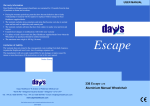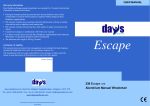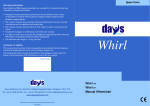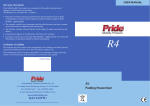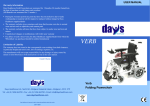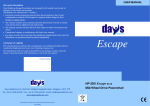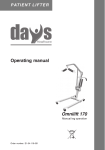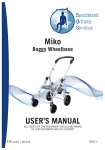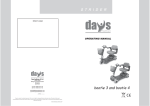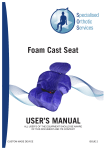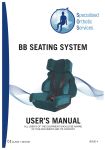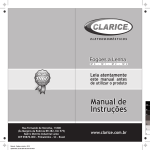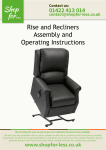Download Link TR Link SP - Days Healthcare
Transcript
USER MANUAL Days Healthcare Link Wheelchair Warranty Information User Manual Days Healthcare Link manual wheelchairs are warranted for 24 months from the date of purchase on frame and crossbars. • During the warranty period any parts that have become defective due to faulty • • • • • workmanship or material will be repaired or replaced without charge by Days Healthcare supplier/dealer The warranty excludes tyres, punctures and items that become worn due to normal wear and tear such as upholstery and armrest pads The warranty excludes all items that have been subject to undue wear and tear and misuse Unauthorised changes or modifications will forfeit your warranty If a defect or fault is discovered, the Days Healthcare supplier/dealer from whom the Wheelchair was purchased should be notified immediately The maximum user weight is 130kg (20 stone) Link Limitation of liability The warranty does not extend to the consequential costs resulting from fault clearance, in particular freight and travel costs, loss of earnings, expenses, etc. The manufacturer will not accept responsibility for any damage or injury caused by misuse or non-observance of the instructions set out in this user manual. Dealer Stamp Days Healthcare Ltd • North Rd • Bridgend Industrial Estate • Bridgend • CF31 3TP Tel: +44 (0) 1656 664700 • Fax: +44 (0) 1656 664750 • Email: [email protected] www.dayshealthcare.com Days Healthcare Ltd reserves the right to change the specifications without prior notice. D/N: W1-053-01 Link TR Link SP Aluminium Manual Wheelchairs Days Healthcare Link Wheelchair User Manual Days Healthcare Link Wheelchair User Manual Technical Specifications Table of Contents Transit Introduction 4 Manual Brake 9 Intended Use 4 Folding Back 9 Technical Description 4 Folding the Chair 9 Feature Guide 5 Unfolding the Chair 10 Safety Guidelines 6 Removal of Rear Wheels 10 Safe Operation 7 Fitting Rear Wheels 10 Self propelled Seat Width 36 - 48 cm (14” - 19”) 36 - 48 cm (14” - 19”) Seat Depth 43 cm (17”) 43 cm (17”) Seat Height (front) 50 cm (20”) 50 cm (20”) Seat Height (rear) 47cm (18½”) 47cm (18½”) Backrest Height (min) 41cm (16”) 41 cm (16”) Backrest Height (max) 45 cm (18”) 45 cm (18”) Adjustment Procedures 8 Basic Propulsion 10 Footrest Length (min) 40 cm (16 ”) 40 cm (16 ”) Footrest Adjustments 8 Transferring to and from the Chair 11 Footrest Length (max) 49 cm (19½”) 49 cm (19½”) Heel and Calf Straps 8 Tyres 11 Armrest Height 25 cm (10”) 25 cm (10”) Backrest Height 8 Slopes & Gradients 11 Overall Length - W Footrests 101cm (40”) 101cm (40”) Seat Belt 8 Transportation 12 Overall Length - W/O footrests 79cm (31”) 79cm (31”) Anti-tippers 8 Maintenance Inspection 13 Overall Width (open) 62cm (24½”) 62cm (24½”) Operations of Use 9 Cleaning 13 Overall Width (folded) 30cm(12”) 30cm(12”) Footrests 9 Technical Specifications 14 Overall Height 92cm (36”) 93-98cm(36½ - 38½”) Overall Height - Back folded 76cm(30”) 75 - 80cm(29½ - 31½”) Armrests 9 Folding Handle Length 20cm(10”) 20cm(10”) 15.5kg 17.5kg N/A 14kg 130kg (20stone) 130kg (20stone) Chair Weight Chair Weight without Wheels Maximum User Weight - 14 - -3- Days Healthcare Link Wheelchair User Manual Introduction Maintenance & Inspection Welcome to the Days Healthcare Link manual wheelchair and thank you for choosing our product. This latest model has been designed with specific practical user needs in mind. It combines solid, rugged construction, safety and performance. We are confident that it will prove a reliable companion in your home as well as outdoors. We recommend that your wheelchair is serviced by your local dealer every twelve months. It is in your best interests, not only to ensure your personal safety but also to ensure long life and reliability. Regular service will identify early damage and worn components avoiding unnecessary faults occurring. This manual contains some useful tips and information on safety, operation and maintenance. Please read it carefully to ensure that you get maximum enjoyment and benefit from your new independence and mobility. Whenever you require special advice and attention do not hesitate to contact your local Days Healthcare dealer. He has all the equipment and know-how to provide an expert service and assistance on technical and clinical applications to suit your particular need. Weekly check that: • Manual brakes do not rub the tyres and secure the wheel when locked • Castor bolts are tight and all fasteners are secure • Arms operate and lock securely in front of rear sockets • The drive wheels axles are secure and there is no excessive side movement or binding when spun • Tyres do not show excessive wear or damage • Castors for proper tension, i.e. spinning castors should come to gradual stop Intended Use The Link manual wheelchairs are intended to assist and improve mobility for those individuals who are less able or have walking difficulties who wish to maintain their independence and freedom. Your day to day activities will depend on your physical capabilities and your own specific circumstances. If in doubt seek medical advice first. The information is this booklet provides a general guide on how to use your chair safely and correctly. Do not use the chair without reading this manual first. Technical Description The Days Healthcare Escape manual wheelchair has a maximum carrying capacity of 130kg (20stone) which must never be exceeded. It is classified as an ‘Invalid Carriage’ for use indoors, on pavements, footpaths, pedestrian zones and areas free from motor traffic. Use on the road or highway is not allowed except for the purpose of crossing. -4- Monthly check that: • Tyres are not excessively worn • Handrims do not have sharp edges or any abrasion • The chair rolls straight (no excessive drag or pull to one side) • Pivot points are free of wear or looseness • Seat and backrest upholstery is not for ripped or sagging • Frames are not worn or bent Cleaning Paintwork and plastic mouldings can be cleaned with a damp soft cloth of warm soapy water. Do not use any harsh abrasive cleaners, bleach base fluids or solvents. Seat and back upholstery can be cleaned with a general purpose upholstery cleaner or sponged with warm soapy water. - 13 - Days Healthcare Link Wheelchair User Manual Transportation Feature Guide We recommend that you do not sit on your Wheelchair when in a vehicle, but transfer to a vehicle seat. A Wheelchair secured in a vehicle will not provide the equivalent safety level and security as the vehicle’s seating systems. However, when transfer is not practical or impossible, ensure the following: 1) Check that the vehicle is suitably designed, insured and equipped to transport a passenger seated in a Wheelchair 2) Remove any part of the Wheelchair (accessories, etc.) that can be easily detached and store it in the vehicle’s luggage hold 3) Make sure the Wheelchair is transported in a forward facing direction. Rearward facing is only acceptable if the passenger’s head and back can be supported by a suitable bulkhead 4) Use the buckle seat belt (if fitted) with your chair as additional restraint Link TR Folding Back Armrest Manual Brake Footrest Footplate Transit Wheel Front Castor Link SP Folding Back Armrest Self-propelled Wheel We recommend that the wheelchair is secured within the vehicle using the 4point webbing tie-down system with Karibiner, model no WWR/ATF/K/R (available from Unwin Safety Systems based in Yeovil, U.K.) Note: Although safety during transportation largely depends upon the diligence of the person securing the tie-downs and passenger restraints it is the user’s responsibility to ensure that the wheelchair has been safely secured. Footrest Hand rim Footplate Front Castor - 12 - -5- Days Healthcare Link Wheelchair User Manual Safety Guidelines Do not use on the road, except when crossing between pavements. When crossing the carriageway of a public road always take extra care and observe the Highway code Do not ride over deep, soft terrain (soft dirt, loose gravel, deep grass) Do not attempt to mount a kerb without assistance Do not carry passengers We recommend that you do not sit on your wheelchair when in a vehicle, but transfer to a vehicle seat Always engage a slow speed when going down gradients Do not ride in reverse down a slope or kerb Always keep your feet on the footplate when moving Do not stand on the footplate when getting in or out of the chair We recommend the use of safety belt Always keep your pneumatic tyres to the correct pressures Do not use parts, accessories or adapters other then those authorised by Days Healthcare Ltd Keep the wheelchair away from children. It is not intended to be used as a toy The manual parking brakes are not designed for slowing-down Rear Wheel Setup This product is supplied as standard with the rear axle bracket in the forward position giving a more active driving position. If the user needs to have a more stable position the rear axle fixing plate can be re-located to give a longer wheelbase and provide a more stable driving position. To Change Axle Position on Rear Wheel Setup 1.Remove wheels TR versions are bolted, For the SP please refer to page 10 2. Unbolt axle brackets and re-locate to the required position. Repeat the process for the opposite side ensuring both axles are correctly located and all fixings are secure. 3. Refit wheels ensuring that the two inner ball bearings lock the wheels in place. 4. Slacken off the brake fixing bolts and re-align brakes to approximately 20mm from the tyre in the unlocked position. Tighten bolts and check function of brakes. -6- Transferring to and from the Chair Circumstances and individual needs will vary from person to person, but if there are difficulties we advise you to consult your therapeutic advisor who will help you to develop your skill for appropriate transfer method that suits you. During transfer always make sure that the brakes are in a locked position and the wheelchair is manoeuvred as close as possible to the transfer seat Tyres Regularly check the condition of front & rear tyres for wear and tear. Contact your supplier for replacements. If you have pneumatic tyres fitted, the pressure indicated on the side of the tyre wall should not be exceeded. Slopes and Gradients Do not attempt to climb or descend beyond your limitations to avoid tipping over. Climbing Upwards Lean the upper body forward and move the wheelchair forwards with short quick pushes on the Handrims. Downward Travel BE CAREFUL Lean backwards in the chair and let the handrim slide gently through your hands to control downward speed and direction. Note: - When travelling down or up a slope, avoid sharp turns, zigzag movements or moving across the slope - 11 - Days Healthcare Link Wheelchair User Manual Unfolding the Chair When both wheels have been secured (SP version), grasp both side frames of the wheelchair and pull apart as far as possible or at least until there is sufficient room to push down on the sides of the seat canvas. The chair is fully open when the seat canvas is taut and flat. Safe Operation When using indoors beware of narrow doors, steps, high surfaces, protruding wall fittings and everyday household items such as children’s toys, electrical appliances etc. Take extra care in kitchen environments. To ensure stability and safe control you must maintain proper balance at all times. The wheelchair is designed to remain stable during normal use as long as you do not move you centre of gravity outside the normal seating position. When reaching/bending forward do not lean your body out of the wheelchair further than the length of the armrests. Do not attempt to reach objects by sliding forwards to the edge of the seat. When reaching/bending backwards do not reach any further than your arm will extend without changing your seating position. Never attempt to use an escalator or stairway, always use a lift. Removal of Rear Wheels SP (Self-propelled Model) Occasionally check that the adjustments of the footrests, armrests and controller are secure and are set in the most comfortable position for use. The rear wheels are removed by depressing the rubber cover at the centre of the wheel hub and withdrawing the wheel. Fitting Rear Wheels (Self-propelled Model) The Link SP wheelchair is fitted with quick release rear wheels. It is important to ensure that wheels are correctly fitted to avoid accidents. To fit rear wheels depress rubber cover at the centre of the wheel hub and push the wheel spindle firmly into the axle bush, ensuring that both ball bearings are fully exposed beyond the axle bush. Once located, test the wheel for security by pulling the wheel firmly in an attempt to remove it without depressing the rubber cover. Basic Propulsion To move forwards or backwards, the user should release the brakes, grasp the handrims (attached to rear wheels) and with a pushing action rotate them forwards or pull them backwards respectively. To move to the right, hold the right handrim steady and push forward with the left handrim. To move to the left, hold the left handrim steady and push forward the right handrim. - 10 - -7- Days Healthcare Link Wheelchair User Manual Adjustment Procedures Operations of Use Footrest Adjustments Footrests Using the hexagon key provided, unscrew the screws located on the rear of the footrest support tube (arrowed). Your footrests are capable of being rotating inwards and outwards. To achieve this pull the release lever (arrowed right) upwards and rotate footrest in the required direction. The footrest may be removed whilst in either position but not whilst in the normal central position (as pictured). Slide the footrest inner tube up or down to the required position and secure in using both screws. Armrests Heel and Calf Straps Your wheelchair is equipped with heel straps which are secured to the footplates Backrest Height a Both armrests are swing-back and removable. To operate, push the release lever (a) and lift arm out of front socket. Rotate arm through 90° to rear of chair. The backrest tubes slide into the rear tube of each side frame through which each has a screw and hand wheel to secure. To remove armrest pull plunger (b) and hold whilst simultaneously pulling the arm from the rear socket. To adjust the backrest, remove both screws and adjust to the required height and refit screws to secure. Refit in the reverse order. b c Illustration shows TR model Manual Brake Seat Belt (if fitted) Hold the bayonet end in one hand, and pull on the webbing to increase or decrease belt length with the other. When length is correct, adjust slide buckle to suit. Adjustable anti-tippers These are fitted at the rear of the chair, adjacent to the rear wheels Days recommends that these are fitted and correctly adjusted to the individuals needs, especially when climbing kerbs and gradients. To adjust, using forefinger and thumb ease the steel washer (arrowed) until the tube can be moved to the desired position, release the washer to lock the tube. To ensure the tube is secure try to move the tube, if it is not locked it will move until it automatically locks with an audible click. The parking brake (c) which is applied manually to the tyres whilst the chair is parked or stationary. To apply the brake, move the lever until the locking bar is locked firmly onto the tyre. Folding Back This is available to reduce the overall height of the chair to allow easier transportation. Whilst at the rear of the chair, grip the small lever (arrowed opposite) and pull away from the chair to release the pin allowing the handle section to be folded down. Folding the Chair Remove the seat cushion (if fitted). The wheelchair is folded by grasping the seat canvas at the front centre with one hand and at the rear with the other. A simple lifting action will draw both sides of the chair together into the folded position. -8- -9-









